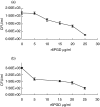Pneumococcal 6-phosphogluconate-dehydrogenase, a putative adhesin, induces protective immune response in mice
- PMID: 16634799
- PMCID: PMC1809659
- DOI: 10.1111/j.1365-2249.2006.03047.x
Pneumococcal 6-phosphogluconate-dehydrogenase, a putative adhesin, induces protective immune response in mice
Abstract
For most bacteria, adherence to human cells is achieved by bacterial lectins binding to mammalian surface glyconjugates. 6-Phosphogluconate dehydrogenase (6PGD) was identified by us as one of Streptococcus pneumoniae cell wall lectin proteins, which elicits an age-dependent immune response in humans. This study assesses the role of 6PGD in S. pneumoniae pathogenesis as an adhesin and its ability to elicit a protective immune response in mice. Recombinant 6PGD (r6PGD) was cloned from S. pneumoniae serotype 3 (strain WU2). r6PGD interference in adhesion of three genetically unrelated unencapsulated pneumococcal strains (3.8, 14.8 and R6) and two genetically unrelated encapsulated pneumococcal strains (WU2 and D39) to A549 type II lung carcinoma cell was tested. BALB/c mice were immunized with r6PGD and boosted after 3 weeks. Immunized mice were challenged intranasally with a lethal dose of S. pneumoniae. r6PGD inhibited 90% and 80% of pneumococcal adhesion to the A549 cells of three unencapsulated S. pneumoniae strains and two encapsulated S. pneumoniae strains, respectively, in a concentration-dependent manner (P < 0.05). Antibodies to r6PGD produced in mice significantly inhibited bacterial adhesion to A549 cell (P < 0.05). Immunization of mice with r6PGD protected 60% (P < 0.001) of mice for 5 days and 40% (P < 0.05) of the mice for 21 days following intranasal lethal challenge. We have identified 6PGD as a surface-located immunogenic lectin protein capable of acting as an adhesin. 6PGD importance to bacterial pathogenesis was demonstrated by the ability of r6PGD to elicit a protective immune response in mice.
Figures





Similar articles
-
Cloning, expression and characterization of a cell wall surface protein, 6-phosphogluconate-dehydrogenase, of Streptococcus suis serotype 2.Vet Microbiol. 2008 Aug 25;130(3-4):363-70. doi: 10.1016/j.vetmic.2008.02.025. Epub 2008 Mar 6. Vet Microbiol. 2008. PMID: 18403138
-
NADH oxidase functions as an adhesin in Streptococcus pneumoniae and elicits a protective immune response in mice.PLoS One. 2013;8(4):e61128. doi: 10.1371/journal.pone.0061128. Epub 2013 Apr 8. PLoS One. 2013. PMID: 23577197 Free PMC article.
-
Streptococcus pneumoniae surface-exposed glutamyl tRNA synthetase, a putative adhesin, is able to induce a partially protective immune response in mice.J Infect Dis. 2007 Sep 15;196(6):945-53. doi: 10.1086/521028. Epub 2007 Aug 10. J Infect Dis. 2007. PMID: 17703427
-
Protective Immune Responses Elicited by Fusion Protein Containing PsaA and PspA Fragments.Immunol Invest. 2015;44(5):482-96. doi: 10.3109/08820139.2015.1037956. Immunol Invest. 2015. PMID: 26107747
-
Pneumococcal surface adhesin A (PsaA): a review.Crit Rev Microbiol. 2008;34(3-4):131-42. doi: 10.1080/10408410802275352. Crit Rev Microbiol. 2008. PMID: 18728990 Review.
Cited by
-
Proteomic comparison of Entamoeba histolytica and Entamoeba dispar and the role of E. histolytica alcohol dehydrogenase 3 in virulence.PLoS Negl Trop Dis. 2009;3(4):e415. doi: 10.1371/journal.pntd.0000415. Epub 2009 Apr 14. PLoS Negl Trop Dis. 2009. PMID: 19365541 Free PMC article.
-
Bacterial virulence in the moonlight: multitasking bacterial moonlighting proteins are virulence determinants in infectious disease.Infect Immun. 2011 Sep;79(9):3476-91. doi: 10.1128/IAI.00179-11. Epub 2011 Jun 6. Infect Immun. 2011. PMID: 21646455 Free PMC article. Review.
-
Exploiting Correlations between Protein Abundance and the Functional Status of saeRS and sarA To Identify Virulence Factors of Potential Importance in the Pathogenesis of Staphylococcus aureus Osteomyelitis.ACS Infect Dis. 2020 Feb 14;6(2):237-249. doi: 10.1021/acsinfecdis.9b00291. Epub 2019 Nov 26. ACS Infect Dis. 2020. PMID: 31722523 Free PMC article.
-
6-Phosphogluconate dehydrogenase and its crystal structures.Acta Crystallogr F Struct Biol Commun. 2022 Mar 1;78(Pt 3):96-112. doi: 10.1107/S2053230X22001091. Epub 2022 Feb 23. Acta Crystallogr F Struct Biol Commun. 2022. PMID: 35234135 Free PMC article. Review.
-
Identification of fibrinogen-binding proteins of Aspergillus fumigatus using proteomic approach.Mycopathologia. 2012 Mar;173(2-3):73-82. doi: 10.1007/s11046-011-9465-z. Epub 2011 Aug 26. Mycopathologia. 2012. PMID: 21870122
References
-
- Centers for Disease Control and Prevention. Prevention of pneumococcal disease. Recommendations of the Advisory Committee on Immunization Practices. MMRW. 1997;46:1–24. - PubMed
-
- Musher DM. Infection caused by Streptococcus pneumoniae: clinical spectrum, pathogenesis, immunity and treatment. Clin Infect Dis. 1992;14:801–9. - PubMed
-
- Tuomanen EI, Masure HR. Molecular and cellular biology of pneumococcal infection. In: Tomasz A, editor. Streptococcal pneumoniae. New York: Mary Ann Liebert, Inc.; 2000. pp. 295–308. molecular biology, mechanism of disease.
Publication types
MeSH terms
Substances
LinkOut - more resources
Full Text Sources
Other Literature Sources

